Bach meets Jazz – Jacques Loussier plays BACH
Subscribe & download the best scores and sheet music transcriptions from our Library.
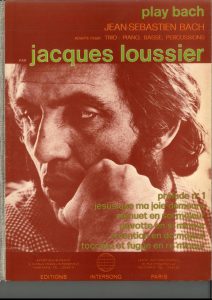
Jacques Loussier
Jacques Loussier (26 October 1934 – 5 March 2019) was a French pianist and composer. He arranged jazz interpretations of many of the works of Johann Sebastian Bach, such as the Goldberg Variations. The Jacques Loussier Trio, founded in 1959, played more than 3,000 concerts and sold more than 7 million recordings—mostly in the Bach series.
Loussier composed film scores and a number of classical pieces, including a Mass, a ballet, and violin concertos. Loussier’s style is described as third stream, a synthesis of jazz and classical music, with an emphasis on improvisation.
Browse in the Library:
| Artist or Composer / Score name | Cover | List of Contents |
|---|---|---|
| The Tom And Jerry Show – Hiromi Uehara (Piano Solo Sheet Music) (Musescore File).mscz | ||
| The Tommy Flanagan Collection |
 |
The Tommy Flanagan Collection |
| The Truman show – Dreaming Of Fiji – Philip Glass |
 |
|
| The Truman show – Reunion – Philip Glass | ||
| The Truman show – Truman Sleeps – Philip Glass | Truman sleeps | |
| The Trumanshow – Dreaming Of Fiji – Philip Glass | ||
| The Trumanshow – Truman Sleeps – Philip Glass | ||
| The Ultimate Fake Book 2nd Edition for keyboard, vocal, guitar and all C inst. |
 |
The Ultimate Fake Book 2nd Edition for keyboard, vocal, guitar and all C inst |
| The Ultimate Gospel Choir Book Vol4 |
 |
The Ultimate Gospel Choir Book Vol4 |
| The Ultimate Pop Rock Fake Book A-Z (ebook) |
 |
The Ultimate Pop Rock Fake Book A-Z (ebook) |
| The Ultimate Pop Rock Fake Book Joel Withburn |
 |
The Ultimate Pop Rock Fake Book Joel Withburn |
| The Untouchables – Main Title – Morricone (Musescore File).mscz | ||
| The Used – Smother Me | ||
| The Utimate Broadway Fake Book |
 |
The Utimate Broadway Fake Book – Hal Leonard |
| The Very Best Of John Williams – Dan Coates arr. easy piano |
 |
The Very Best Of John Williams – Dan Coates arr. easy piano |
| The Very Best Pop Songs Of All Time 19 of the best-ever pop songs Piano voica and guitar chords |
 |
The Very Best Pop Songs Of All Time |
| The Village – The Gravel Road – James Newton Howard | ||
| The Visible And Invisible In Pianoforte Technique (By Tobias Matthay) (1947) |
 |
|
| The way we were – Barbara Streisand | The way we were – Barbara Streisand | |
| The Way We Were – Piano And Vocal (Musescore File).mscz | ||
| The Way We Were – Piano and vocal Barbra Streisand | The Way We Were – Piano and vocal | |
| The Way We Were (Lead sheet with Guitar chrods and lyrics ) |
 |
|
| The Way We Were (Lead Sheet With Lyrics ) (Musescore File).mscz | ||
| The Way We Were (Musescore File).mscz | ||
| The Wedding Night (Frankenstein OST) Patrick Doyle | ||
| THE WHO – The Who Anthology |
 |
The Who Anthology Contents |
| The Who – Guitar Play Along Volume 108 WITH mp3 audio tracks with Tablature |
 |
Guitar Play-Along Volume 108 – The Who |
| The Who – Tommy (Piano-Vocal-Guitar) |
 |
The Who – Tommy |
| The Who Rockscore |
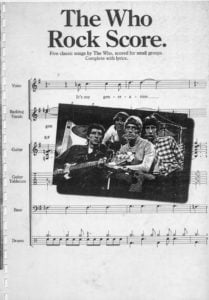 |
|
| The Who The Acoustic Guitar Collection Guitar Songbook TABs |
 |
The Who The Acoustic Guitar Collection Guitar Songbook TABs contents |
| The Who The Definitive Collection Volume A E Guitar TABs Songbook |
 |
The Who The Definitive Collection Volume A E Guitar TABs Songbook |
| The winner takes it all (Abba) | ||
| The Wizard of Oz – (Harold Arlen) Vocal & piano score |
 |
The Wizard of Oz – (Harold Arlen) -vocal.piano.score |
| The Wizard Of Oz The Musical by Andrew lloyd Webber |
 |
The Wizard Of Oz Musical Webber |
| The Wonder of Life (Afterwards OST) Alexandre Desplat | ||
| The Wonders – That Thing You Do | ||
| The Words And Music Of Frank Zappa By Kelly Fisher Lowe (Book) |
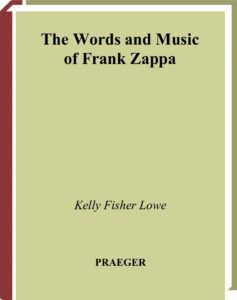 |
|
| The World Hits Of Oldies (Jazz Fake book) |
 |
|
| The World’s best music (Famous Compositions for Piano Vol. 1) 1904 | The world’s best music | |
| The World’s best music V Famous compositions for the piano |
 |
The World’s best music V Famous compositions for the piano |
| The World’s Greatest Fake Book |
 |
Greatest Fake Book |
| The Worlds best music I Famous compositions for the piano |
 |
The Worlds best music I Famous compositions for the piano |
| The Yellow Rose Of Texas – Traditional (Musescore File).mscz | ||
| The Young Pianist’s Anthology Of Modern Music (1972) |
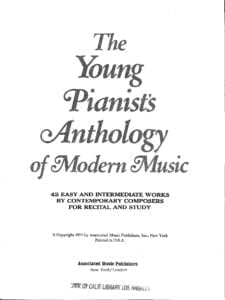 |
The Young Pianist’s Anthology Of Modern Music (1972) |
| The Zombies Songbook |
 |
|
| Thegogos – Head Over Heels | ||
| Thelonious Monk Compositions (as recorded by himself) | Thelonious Monk’s Compositions Fake Book – (Jazz) | |
| Thelonious Monk Blue Sphere |
 |
|
| Thelonious Monk easy piano solos Jazz |
 |
Thelonious Monk easy piano |
| Thelonious Monk – Japanese Folk song (Kojo No Tsuki) (sheet music transcription) |
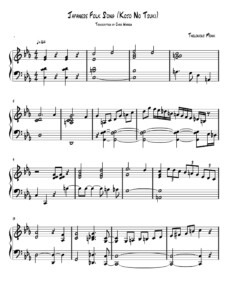 |
|
| Thelonious Monk – Jazz Masters |
 |
Thelonious Monk – Jazz Masters |
| Thelonious Monk – Originals and standards |
 |
Thelonius Monk originals |
| Thelonious Monk – The Man I Love (solo) Gershwin |
 |
|
| Thelonious Monk & Cootie Williams – ‘Round Midnight | Thelonious Monk & Cootie Williams – ’round Midnight | |
| Thelonious Monk Collection | Thelonius Monk Collection | |
| Thelonious Monk Collection 12 Note For Note Solo Piano Transcriptions Artist Piano Transcriptions |
 |
Thelonious Monk Collection 12 Note For Note Solo Piano Transcriptions Artist Piano Transcriptions |
| Thelonious Monk Compositions (as recorded by himself) | Thelonious Monk’s Compositions Fake Book – (Jazz) | |
| Thelonious Monk Fake Book | Thelonious Monk Fake Book | |
| Thelonious Monk Fake Book C Edition |
 |
Thelonious Monk Fake Book C Edition |
| Thelonious Monk For Guitar with TABs |
 |
Thelonious Monk For Guitar |
| Thelonious Monk Intermediate Piano Solos Arranged By Ronnie Mathews 14 Arrangements |
 |
Thelonious Monk Intermediate Piano Solos Arranged By Ronnie Mathews 14 Arrangements |
| Thelonious Monk Jazz Piano Collection |
 |
Thelonious Monk Jazz Piano Collection |
| Thelonious Monk Jazz Piano Solos Series Volume 49 |
 |
Thelonious Monk Jazz Piano Solos Series Volume 49 |
| Thelonious Monk Omnibook for piano Transcribed exactly from his recorded solos |
 |
Thelonious Monk Omnibook for piano Transcribed exactly from his recorded solos |
| Thelonious Monk Plays Standards – Volume 1 Artist Transcriptions Piano 12 transcriptions |
 |
Thelonious Monk Plays Standards – Volume 1 Artist Transcriptions Piano 12 transcriptions |
| Thelonious Monk Plays Standards – Volume 2 Artist Transcriptions Piano 12 transcriptions |
 |
Thelonious Monk Plays Standards – Volume 2 Artist Transcriptions Piano 12 transcriptions |
| Thelonious Monk Quartet featuring John Coltrane at Carnegie Hall (Book) |
 |
|
| Thelonious Monk Revealing Instincts Of The Genius Of Jazz Piano Originals |
 |
Thelonious Monk The Genius Of Jazz |
| Thelonious Monk Round Midnight Jazz Standard arr. Carsten Gerlitz |
 |
|
| Thelonious Monk Solo Transcriptions |
 |
Thelonious Monk Solo Transcriptions |
| Thelonious Monk Tea For Two (piano solo transcription sheet music, partition) | Thelonious Monk Tea For Two (piano solo transcription sheet music, partition) | |
| Thelonius Monk – Monk’s Music and Jazz History in the making (Book) |
 |
|
| Thelonius Monk – Thelonious transcription | Thelonius Monk – Thelonious transcription | |
| Theme de Charles (Un homme et son chien OST) Philippe Rombi | ||
| Thème de Jeanne – Le Diable par la Queue OST (Georges Delerue) | ||
| Thème de Jeanne – Le Diable par la Queue OST (Georges Delerue) trio version | ||
| Theme de Suzanne – Potiche OST (Philippe Rombi) | ||
| Theme from the Mermaid Chair (Secret Garden) | ||
| Theme From The Simpsons Jazz Play Along (Musescore File).mscz | ||
| Theodore Shapiro Diary Of A Wimpy Kid – Main Titles |
 |
|
| Theodore Shapiro Louder Than Thunder The Devil Wears Prada Theme Piano Solo Arr. |
 |
|
| Theodore Shapiro Severance Main Theme |
 |
|
| Theodore Shapiro Suite from The Devil Wears Prada Theme Piano Solo |
 |
|
| Theory Essentials An Integrated Approach To Harmony, Ear Training, And Keyboard Skills (Connie E. Mayfield) Book |
 |
|
| Theory of Harmony – Arnold Schoenberg | Book Theory | |
| These Foolish Things Sheet Music Ella Fitzgerald |
 |
|
| Thinking In Jazz The Infinite Art of Improvisation Berliner, Paul (Book) 1994 |
 |
|
| This Is Halloween Easy Piano |
 |
|
| This Is Us Songbook Selections From The Television Series Soundtrack |
 |
|
| This Land Is Your Land (Guitar Chords) (Musescore File).mscz | ||
| This Land Is Your Land (Musescore File).mscz | ||
| This Little Light of Mine (African-American Spiritual) from The Best Children’s Songs Ever (Easy Piano) | This Little Light of Mine (African-American Spiritual) from The Best Children’s Songs Ever (Easy Piano) | |
| This Little Light of Mine (African-American Spiritual) from The Best Children’s Songs Ever (Easy Piano) Musescore file.mscz | ||
| Thomas Attwood Allegro First Movement From Sonatina No. 1 In G (Trinity Grade 2 Piano) |
 |
|
| Thomas Attwood – Allegro – First Movement from Sonatina No. 1 in G (Trinity Grade 2 Piano).mscz | ||
| Thomas Johnson READ AND PLAY New Series Grades II, III and IV Piano |
 |
|
| Thomas Newman – Any Other Name (American Beauty Theme) | Thomas-Newman-Any-Other-Name-American-Beauty 1st page | |
| Thomas Newman – Road To Perdition – Road To Chicago |
 |
|
| Thomas Newman – Road To Perdition (Piano Solo) |
 |
|
| Thomas Newman – Road To Perdition Theme – Guitar Tabs |
 |
|
| Thomas Newman – The Horse Whisperer – Montana | Thomas Newman – The Horse Whisperer – Montana | |
| Thomas Newman – The Horsewisperer – The Vast Continent |
 |
|
| Thomas Newman – The Horsewisperer – Voice Of God | Thomas Newman – The Horsewisperer – Voice Of God | |
| Thomas Newman – The Shawshank Redemption – Stoic Theme |
 |
|
| Thomas Newman Forbidden Love (Meet Joe Black) | ||
| Those Were The Days (Musescore File).mscz | ||
| Those Were The Days Russian Traditional Jazzy Version | Those Were The Days Russian Traditional Jazzy Version | |
| Three Coins In The Fountain 1954 by Jule Styne and Sammy Cahn |
 |
|
| Three Days Grace – Never Too Late | ||
| Tidus And Yuna’s Theme (Musescore File).mscz | ||
| Tifa’s Theme (Final Fantasy VII Piano Collections) |
 |
|
| Tifa’s Theme Final Fantasy Vii Piano Collections (Musescore File).mscz | ||
| Tim Minchin – Miracle (Matilda the Musical) | Tim Minchin – Miracle (Matilda the Musical) | |
| Tim Minchin – Prejudice (Musical Comedy) Piano Sheet Music | Tim Minchin – Prejudice (Musical Comedy) Piano Sheet Music | |
| Tim Richards Improvising blues piano (PDF + MP3 audio tracks) |
 |
Improvising Blues Piano (with audio Mp3) |
| Tim Richards – Exploring Jazz Piano Vol. 1 (with MP3 audio tracks) |
 |
Tim Richards Exploring Jazz Piano 1 |
| Tim Richards – Exploring Jazz Piano Vol. 2 (with MP3 audio tracks) |
 |
Exploring jazz piano 2 |
| Tim Richards – Exploring Latin Piano (with audio MP3) |
 |
Tim Richards – Exploring Latin Piano |
| Tim Smith Cardiacs All Spectacular Piano Solo |
 |
|
| Tim Smith Cardiacs Savour Piano Solo |
 |
When Loussier began applying jazz improvisation and swing to Johann Sebastian Bach’s exquisite symmetries, some jazz pundits and fans dismissed it as a betrayal of an African-American music’s expressive earthiness and blues roots, aimed at an audience that preferred its jazz pretty rather than passionate. And from the classical angle, observers were liable to perceive the young Frenchman’s work as little short of vandalism.
The New York Times critic John Rockwell’s review of a Loussier concert at Carnegie Hall in 1975 reflected that distaste when he proclaimed: “There is a certain sort of sensibility that is actively appalled by the very notion of ‘popularising’ Bach – or any classical composer, for that matter. This listener’s sensibility is one of those, and so he found the Tuesday evening performance at a sparsely attended Carnegie Hall by the Jacques Loussier Trio tiresome and offensive.”
Nonetheless, the success of concerts and recordings by Loussier and his Play Bach trio (originally formed with the eminent Paris jazz sidemen Pierre Michelot on bass and Christian Garros on drums) took off almost overnight from the group’s first appearances in 1959 – shifting millions of Play Bach recordings in the almost two-decade life of the original band.
The group’s suitably chilled-out, languidly hip treatment of Bach’s Air on the G String famously accompanied the Hamlet cigar company’s TV advertising from 1962, with cinema versions finally being banned at the end of the century, though these soundtracks did not include Michelot’s subsequent driving bass-walk and Loussier’s freewheeling improv theme-stretches.
Loussier, however, was no one-trick populist who had chanced on a hit formula and milked it. A piano virtuoso from early childhood, he attended the Conservatoire National de Musique in Paris from his mid-teens under a celebrated mentor – the classical pianist and educator Yves Nat – travelled in the Middle East and Latin America absorbing musical ideas in his early 20s, and composed scores for more than 60 films and TV shows. There was also the tireless touring of the Play Bach trio – and after its breakup, he worked on both acoustic and electronic projects at his own Studio Miraval in Provence.
Born in Angers, in western France, Loussier began piano lessons at the age of 10, and within a year was fascinated by the music of Bach. When he heard a piece from the Notebook for Anna Magdalena at 11, he took to playing it incessantly. “I was studying this piece and I just fell in love with it,” Loussier told an interviewer in 2003. “Then I found I loved to play the music, but add my own notes, expanding the harmonies and playing around with that music.”
In this, as Loussier was later to observe, he was not subverting Bach but paying his respects to an improvising tradition to which the composer also belonged, even if classical music’s subsequent assumptions preferred to bury that unruly element.
Loussier’s potential had been brought to Nat’s attention when he was 13, and Nat supplied him with practice projects that the boy would visit Paris every three months to demonstrate. At 16 he entered the conservatoire, financing his courses by playing jazz in the city’s bars.
In the mid-1950s Loussier then took off on his travels, which included Cuba, where he stayed for a year. Back home, he found work as an accompanist, to the singer and actor Catherine Sauvage and Charles Aznavour.
Loussier later recalled that in 1959 he had told Decca Records that he was a classical pianist and they said they already had plenty. Then he said he was a jazz pianist and they said they had plenty of those, too. “Finally I started to play some Bach with my improvisations and they said, ‘What is that? Why don’t we make a record of that?’ I was still doing it out of fun. I never thought the public would like it. I was wrong.”
With Michelot and Garros, and with the American chamber-musical Modern Jazz Quartet as a significant and celebrated inspiration, the Play Bach trio made four hugely successful Decca albums between 1960 and 1963, launched a performance schedule rarely numbering fewer than 150 shows a year worldwide, and expanded the repertoire to include double-tracked recordings of Loussier parts on organ and piano, and arrangements of Bach concertos.
In the midst of it all, Loussier was also a sought-after composer for film and TV. In 1978, weary of travelling, he wound the trio up and retired to Studio Miraval to explore composition more deeply, experiment with electronics and studio techniques, and play host and offer recording time to visiting rock stars including Pink Floyd, AC/DC and Sade.
He wrote the full-scale symphony Lumières (with the countertenor James Bowman, soprano Deborah Rees and a rock rhythm section on its Paris premiere), concertos for trumpet and violin, strings suites, a ballet score and the crossover fusion works Pulsion, Pagan Moon, and Pulsion Sous la Mer.

But Bach’s 1985 tercentenary had already tempted Loussier back to the piano stool. With the jazz/classical bassist Vincent Charbonnier, followed after illness in the 90s by the comparably virtuosic Benoit Dunoyer de Segonzac and the percussionist André Arpino, Loussier formed a more broadminded, genre-fluid and technically sophisticated version of the Play Bach trio, which if anything amplified just how creatively musical his original vision had been.
Recording for Telarc from 1996, Loussier returned to his beloved Bach, explored Vivaldi’s Four Seasons in improv conversations with Charbonnier and Arpino, with an affectionate nod to the Modern Jazz Quartet’s Django (1997), and Satie, with De Segonzac and Arpino (1998).
Interpretations of Ravel, Beethoven, Mozart and Chopin followed (with the last-named occasioning Loussier’s first solo piano album in his 70th birthday year, on which he breezily threw flamenco, gospel, calypso and stride-piano into the mix), and ambitious Bach homages taking on the Goldberg Variations and the Brandenburg Concertos.
In 2002, the pianist’s life took an unlikely turn when he embarked on a lawsuit against the rapper Eminem for allegedly stealing hooks from Pulsion for the track Kill You from the Marshall Mathers LP – a confrontation eventually settled out of court. In a conversation that year with the writer Sholto Byrnes, Loussier seemed mainly miffed that the Americans had not asked him first, and typically claimed: “I like good music whatever it is.” He later registered an interest in Eminem’s music.
Jazz reference books have not been so generous to Loussier, but, a true jazz improviser rather than an embellisher of the classics, he sidelined the snobberies from both sides in his early years. He paid tribute to the composers he loved with unmistakable and expert devotion, performing long enough to see his inclusive vision of a music with far fewer borders come to pass.
